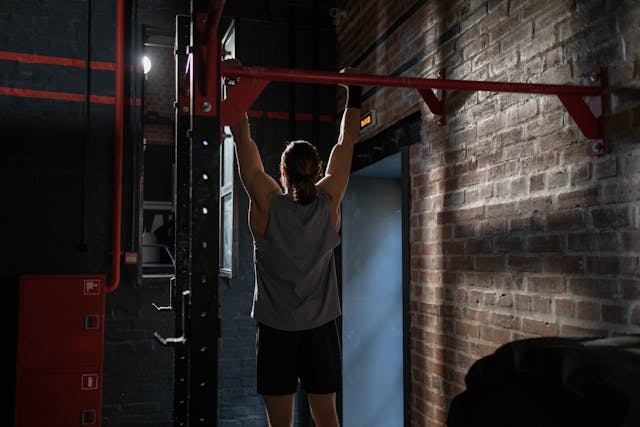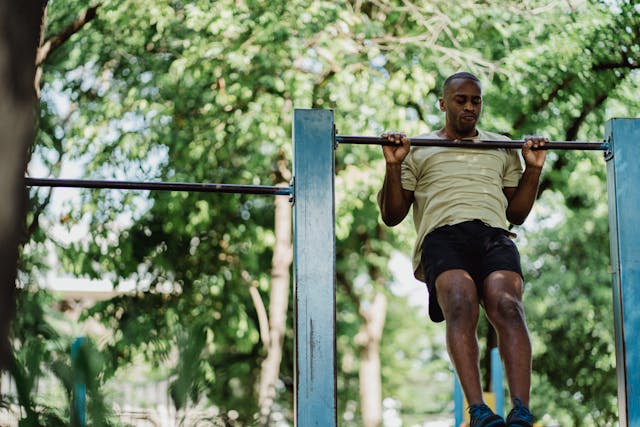Master the fitness exercise Pull-Up. In this guide, we guide you to how to do a pull-up, the variations of pull-ups, the targeted muscles, and why do pull ups.
Table of Content:
Pull-Ups
The pull-up is one of the most fundamental and effective exercises for building upper body strength, admired by fitness enthusiasts and athletes alike. It’s a true test of functional strength, requiring you to lift your body weight using just your arms, shoulders, and back muscles. Although it may seem like a simple movement, mastering the pull-up takes dedication and proper technique. This article will guide you through the mechanics of the pull-up, the muscles it targets, variations, and ways to progress toward achieving your first pull-up or improving your current ability.
Why Do Pull-Ups?
Pull-ups are a compound exercise, meaning they work multiple muscle groups simultaneously. While many exercises isolate muscles, the pull-up is an excellent example of functional fitness, mirroring the movements of everyday activities, such as climbing or lifting. Whether you’re an athlete, a bodybuilder, or someone looking to improve general fitness, pull-ups offer an unparalleled combination of strength development and real-world application.
Beyond strength, pull-ups also engage your cardiovascular system, making them an efficient calorie-burning exercise. Additionally, they improve grip strength, posture, and stability, which are crucial for both athletic performance and daily activities.
So, why do pull-ups?
Pull-ups are a powerhouse exercise with numerous physical and functional benefits. Let’s explore some of them below.
- Builds Upper Body Strength
Pull-ups target several major muscle groups, including the lats, traps, deltoids, biceps, and even the muscles of the chest and forearms. Regular practice can lead to significant strength gains. - Functional Fitness
Pull-ups mimic natural pulling movements, making them an excellent choice for improving functional strength and athletic performance. - Improves Posture
Strengthening the back muscles helps counteract the effects of prolonged sitting, promoting better posture. - Core Engagement
Although primarily an upper-body exercise, pull-ups engage the core muscles to stabilize your body during the movement. - Scalable and Versatile
Pull-ups can be adapted to suit any fitness level, from beginners using assistance to advanced athletes adding weight.
The Muscles Worked in a Pull-Up
The pull-up primarily targets the upper body, with an emphasis on several key muscles.
- Latissimus Dorsi (Lats): These are the large, flat muscles on your back responsible for the “V” shape many people aim for. The lats are heavily engaged during pull-ups as they help pull your upper arms toward your torso.
- Biceps: Although the back muscles take the lead in a pull-up, your biceps (the muscles on the front of your arms) assist in the upward pulling motion.
- Trapezius and Rhomboids: These upper and mid-back muscles stabilize the shoulder blades during the pull-up movement, assisting in proper posture and form.
- Deltoids: The shoulder muscles, particularly the posterior deltoids, are engaged to stabilize the arms and shoulders throughout the movement.
- Core Muscles: The abdominals and obliques engage to stabilize your body, preventing swinging and helping to maintain control throughout the pull-up.

How to Perform a Proper Pull-Up
Though pull-ups may seem straightforward, perfecting the form is crucial for both effectiveness and injury prevention. The following is a step-by-step guide to performing a pull-up from scratch.
- Grip the bar: Start by grabbing the pull-up bar with an overhand grip (palms facing away from you). Your hands should be positioned slightly wider than shoulder-width apart. For beginners, a neutral grip (palms facing each other) may feel more natural and put less strain on the shoulders.
- Hang from the bar: Begin in a dead hang with your arms fully extended. Engage your core by tightening your abdominal muscles to keep your body stable. Your legs should be slightly bent or crossed at the ankles to prevent unnecessary swinging.
- Pull yourself up: Initiate the upward movement by driving your elbows down toward your sides, engaging your back muscles rather than your arms. Focus on keeping your chest open and pulling your chin above the bar. Avoid the common mistake of rounding your shoulders or relying solely on your arms.
- Pause at the top: Once your chin is above the bar, hold the position for a brief second, ensuring that you’ve reached the full range of motion.
- Lower down slowly: Control the descent by slowly lowering your body until your arms are fully extended again. This eccentric (lowering) phase is just as important as the pulling phase, as it helps build muscle endurance and strength.
- Repeat: Aim to complete each repetition with the same control and focus. Quality over quantity is essential to maximizing the effectiveness of the pull-up.
Common Types of the Pull-Up
To keep your workouts challenging and prevent plateauing, it’s important to incorporate different pull-up variations.

A pull-us is incredibly versatile, with numerous variations to challenge different muscles or accommodate different skill levels. The following are some popular options.
Beginner Variations
- Assisted Pull-Ups: Use a resistance band looped around the bar and under your feet for support, or use a pull-up assist machine.
- Negative Pull-Ups: Jump up to the bar so your chin is above it, then lower yourself slowly. This focuses on the eccentric (lowering) phase.
- Australian Pull-Ups (Inverted Rows): Perform pull-ups on a lower bar, keeping your feet on the ground and body at an angle.
Intermediate Variations
- Chin-Ups: Use an underhand grip (palms facing toward you) to emphasize the biceps.
- Wide-Grip Pull-Ups: Place your hands wider apart to target the lats more effectively.
- Close-Grip Pull-Ups: Position your hands closer together to emphasize the biceps and inner back.
Advanced Variations
- Weighted Pull-Up: Add weight using a dip belt or weighted vest for increased resistance.
- Archer Pull-Us: Pull up to one side while extending the opposite arm, resembling an archer drawing a bow.
- One-Arm Pull-Up: The ultimate test of pull-up strength and control, requiring significant practice and strength.
Pull-Up Progressions: How to Work Up to Your First Pull-Up
For many people, performing a full pull-up might seem like a distant goal. However, with the right progressions and consistent practice, anyone can achieve their first pull-up. Let’s see how to work up to it.
Assisted Pull-Ups are one of the easiest ways to get started is by using assistance, either from a resistance band or a pull-up machine. Resistance bands help by taking some of your body weight off the movement, making it easier to perform the pull-up.
Negative Pull-Ups offer a great way to build strength when you can’t yet pull yourself up. Jump or use a step to get your chin above the bar, then slowly lower yourself down to the starting position. The slow, controlled descent strengthens the same muscles used in the upward movement.
Isometric Holds provide another effective method is to hold your chin above the bar for as long as possible. These static holds will build endurance and strength in your back and arm muscles.
Lat Pulldowns mimic the pull-up movement by using a weighted machine, if you have access to gym equipment. This can help build the strength needed to perform pull-ups.
Risks and Safety Considerations
Like any exercise, pull-ups come with risks, especially if performed improperly. There are three common risks.
Potential Risks
- Shoulder or Elbow Strain – poor form or overuse can strain the joints and connective tissues.
- Back or Neck Pain – failing to engage your core or pulling your neck forward can lead to discomfort or injury.
- Grip-Related Injuries – weak grip strength can lead to slipping, increasing the risk of falls.
How to Minimize the Risks
- Warm up thoroughly before starting.
- Focus on proper technique rather than speed or volume.
- Progress gradually, especially if you’re new to pull-up.
Tips for Success
Whether you’re a beginner or looking to advance your pull-up game, these tips can help you progress efficiently.
- Start with Assistance:
- Resistance bands or pull-up assist machines are great tools for building strength.
- Focus on Technique:
- Keep your movements controlled and avoid swinging or using momentum.
- Practice Negative Reps:
- If you can’t do a full pull-up yet, practice the lowering phase to build strength.
- Train Supporting Muscles:
- Incorporate exercises like rows, lat pulldowns, and bicep curls to strengthen the muscles involved.
- Increase Grip Strength:
- Dead hangs, farmer’s carries, and grip trainers can improve your grip over time.
- Be Consistent:
- Include pull-ups in your routine 2-3 times per week to see steady progress.
Our Final Thoughts
Pull-ups are one of the best exercises for developing upper body strength, requiring only your body weight and a bar. Whether you’re a beginner looking to master your first pull-up or a seasoned athlete seeking to improve your performance, focusing on proper form, consistent practice, and gradual progression will lead to success. Incorporating variations, working on your grip strength, and using assisted movements will not only help you build strength but also prevent injury. So grab that bar and start pulling — you’ll be amazed at the progress you can achieve!


